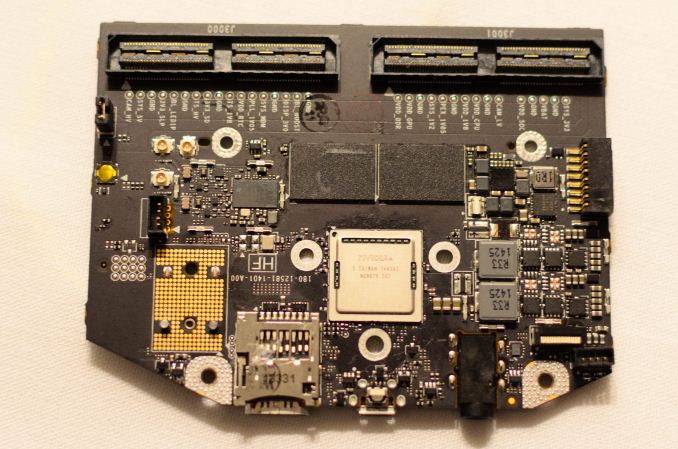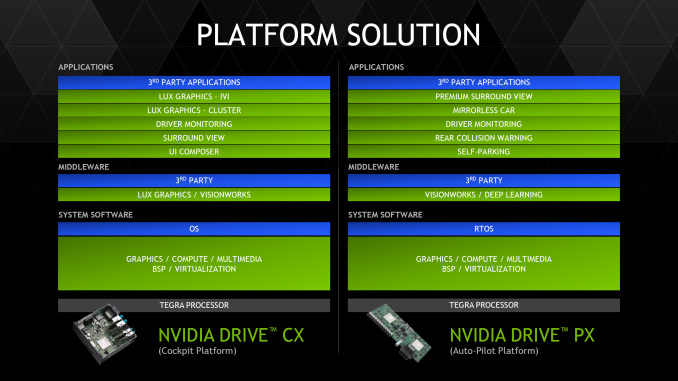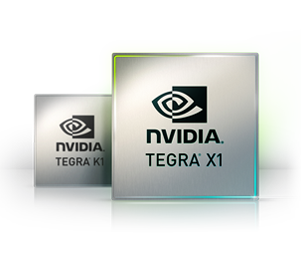NVIDIA Tegra X1 Preview & Architecture Analysis
by Joshua Ho & Ryan Smith on January 5, 2015 1:00 AM EST- Posted in
- SoCs
- Arm
- Project Denver
- Mobile
- 20nm
- GPUs
- Tablets
- NVIDIA
- Cortex A57
- Tegra X1
Final Words
With the Tegra X1, there have been a great deal of changes when compared to Tegra K1. We see a move from Cortex A15 to A57 on the main cluster, and a move from a single low power Cortex A15 to four Cortex A53s which is a significant departure from previous Tegra SoCs. However, the CPU design remains distinct from what we see in SoCs like the Exynos 5433, as NVIDIA uses a custom CPU interconnect and cluster migration instead of ARM’s CCI-400 and global task scheduling. Outside of these CPU changes, NVIDIA has done a great deal of work on the uncore, with a much faster ISP and support for new codecs at high resolution and frame rate, along with an improved memory interface and improved display output.
Outside of CPU, the GPU is a massive improvement with the move to Maxwell. The addition of double-speed FP16 support for the Tegra X1 helps to improve performance and power efficiency in applications that will utilize FP16, and in general the mobile-first focus on the architecture makes for a 2x improvement in performance per watt. While Tegra K1 set a new bar for mobile graphics for other SoC designers to target, Tegra X1 manages to raise the bar again in a big way. Given the standards support of Tegra X1, it wouldn’t be a far leap to see more extensive porting of games to a version of SHIELD Tablet with Tegra X1.
NVIDIA has also made automotive applications a huge focus in Tegra X1 in the form of DRIVE CX, a cockpit computing platform, and DRIVE PX, an autopilot platform. Given the level of integration and compute present in both DRIVE CX and PX, there seems to be a significant amount of value in NVIDIA’s solutions. However, it remains to be seen whether OEMs will widely adopt these solutions as car manufacturers can take multiple years to implement a new SoC. Compared to the 3-4 month adoption rate of an SoC in a phone or tablet, it's hard to pass any judgment on whether or not NVIDIA's automotive endeavors will be a success.
Overall, Tegra X1 represents a solid improvement over Tegra K1, and now that NVIDIA has shifted their GPU architectures to be targeted at mobile first, we’re seeing the benefits that come with such a strategy. It seems obvious that this would be a great SoC to put in a gaming tablet and a variety of other mobile devices, but it remains to be seen whether NVIDIA can get the design wins necessary to make this happen. Given that all of the high-end SoCs in the Android space will be shipping with A57 and A53 CPUs, the high-end SoC space will see significant competition once again.













194 Comments
View All Comments
GC2:CS - Monday, January 5, 2015 - link
And what happened ?kron123456789 - Monday, January 5, 2015 - link
What happend? Only custom-made by Apple GXA6850 can compete with K1 and there is no devices with GX6650. That happend.GC2:CS - Monday, January 5, 2015 - link
Tegra K1 is also custom-made.And A8X can not only compete, but what's more important, compete at a much lower power which matters more than just pure performance.
kron123456789 - Monday, January 5, 2015 - link
I mean that GXA6850 was made by Apple, it's not an ImgTec's design(which was GX6650). And A8X is 20nm SoC and this gives A8X efficiency advantage.GC2:CS - Monday, January 5, 2015 - link
Yeah GXA6850 is an semi-custom design.The efficiency adventage offered by 28 to 20 nm transition is only about 25%, the actual difference between k1 and A8X is much bigger.
techconc - Monday, January 5, 2015 - link
@kronI fail to see your point. Apple was able to put out a CPU/GPU that is both more powerful and more energy efficient than the nVidia based part. The original argument suggested that Apple should switch to nVidia. It's obvious from existing parts that there is no reason to do this. Your argument attempts to suggest otherwise, but fails to make the case. If we're basing the case off of future technology (like the X1) then you also need to discuss the Rogue 7 series chips that quite frankly look more impressive.
aenews - Saturday, January 24, 2015 - link
It is definitely more energy effcient and faster, but not significantly faster. They are on the same level, and there aren't games on iOS that even use that level of power right now.lucam - Tuesday, January 6, 2015 - link
Imgtec licenses design then anybody do what they want. It's the same of ARM with reference design and in house design (cyclone, denver etc). We are always talking about ARM. What the hell you re talking about?lucam - Tuesday, January 6, 2015 - link
Since there is no GX6650 around doesn't mean it cannot compete. Talking about speculations maybe an higher clock of GX6650 can compete who know. Apple did it's custom version, low clock and more cluster. Either way it's always PowerVr inside.kron123456789 - Monday, January 5, 2015 - link
And only compete. Not blows away, like somebody were saying.